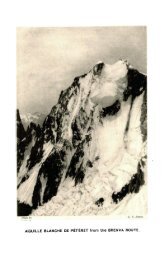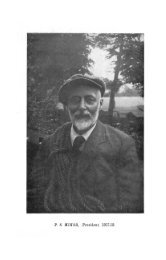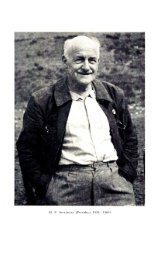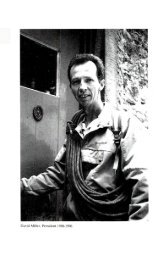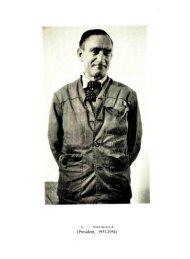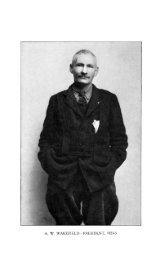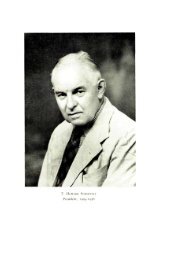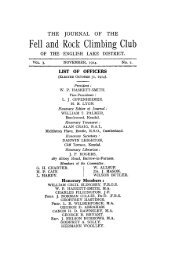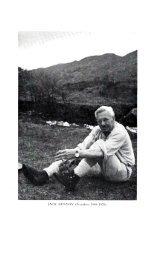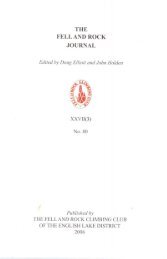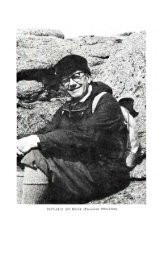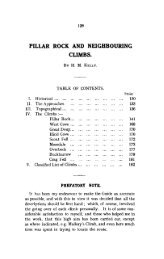Number in series 70; Year of publication 1986 - Fell and Rock ...
Number in series 70; Year of publication 1986 - Fell and Rock ...
Number in series 70; Year of publication 1986 - Fell and Rock ...
Create successful ePaper yourself
Turn your PDF publications into a flip-book with our unique Google optimized e-Paper software.
82 A SHORT HISTORY OF LAKELAND CLIMBING - PART IIIBrown's other route that year, The Hun on Pillar <strong>Rock</strong>, added another f<strong>in</strong>e,airy route to the crag's grow<strong>in</strong>g repertoire <strong>and</strong> signalled the end <strong>of</strong> his <strong>in</strong>spiredexplorations <strong>of</strong> Lakel<strong>and</strong> crags <strong>in</strong> the sixties.1968-19<strong>70</strong> Transition PeriodIt can be argued that climb<strong>in</strong>g st<strong>and</strong>ards <strong>in</strong> the Lake District virtually stoodstill for most <strong>of</strong> the sixties. In the late fifties, several routes such as Post Mortem(1956), Phoenix (1957) <strong>and</strong> Elim<strong>in</strong>ot (1957) had already broached the E2barrier, <strong>and</strong> many <strong>of</strong> the outst<strong>and</strong><strong>in</strong>g classics <strong>of</strong> 1960 — Side Walk, Extol, Astra& Ichabod — were solidly <strong>of</strong> this grade. (Admittedly, each <strong>of</strong> the abovementionedclimbs employed a po<strong>in</strong>t <strong>of</strong> aid, which was subsequently elim<strong>in</strong>ated,but they all possessed the aura <strong>of</strong> this new st<strong>and</strong>ard <strong>of</strong> climb<strong>in</strong>g). Dur<strong>in</strong>g thesixties many formidable l<strong>in</strong>es were ascended, open<strong>in</strong>g up sections <strong>of</strong> cliffpreviously considered unclimbable, but purely <strong>in</strong> terms <strong>of</strong> the top level <strong>of</strong>climb<strong>in</strong>g st<strong>and</strong>ards achieved it may be regarded as a period <strong>of</strong> consolidation <strong>of</strong>the E2 grade. It was not until the f<strong>in</strong>al years <strong>of</strong> the decade that new climbs beganto emerge which showed signs <strong>of</strong> another rise <strong>in</strong> st<strong>and</strong>ards.It is perhaps <strong>in</strong>terest<strong>in</strong>g at this po<strong>in</strong>t to compare progress with other areas.The advancement <strong>of</strong> climb<strong>in</strong>g st<strong>and</strong>ards <strong>in</strong> Scotl<strong>and</strong> roughly paralleled theLakes, with routes like Club Crack (1956), Shibboleth (1958) <strong>and</strong> Carnivore(1958) represent<strong>in</strong>g the first E2's, but the next step forward did not occur thereuntil the mid to late seventies.Wales, however, was significantly ahead <strong>of</strong> both areas. As early as 1952,routes like Bloody Slab were break<strong>in</strong>g <strong>in</strong>to the E2 grade <strong>and</strong> throughout thefifites the development <strong>of</strong> Cloggy saw the production <strong>of</strong> a whole str<strong>in</strong>g <strong>of</strong> newclimbs which were firmly <strong>of</strong> this grade — Slant<strong>in</strong>g Slab, Woubits, Taurus, TheMostest, etc. The ascents <strong>of</strong> November (1957) <strong>and</strong> Woubits Left H<strong>and</strong> (1959),despite us<strong>in</strong>g considerable aid, already h<strong>in</strong>ted at the next rise <strong>in</strong> st<strong>and</strong>ards. Thealmost traditional rivalry between N. Wales <strong>and</strong> the Lakes for produc<strong>in</strong>g thehardest climbs <strong>of</strong> the day has prevailed throughout much <strong>of</strong> Brita<strong>in</strong>'s climb<strong>in</strong>ghistory. In the early fifties the death <strong>of</strong> Arthur Dolph<strong>in</strong> <strong>and</strong> the advent <strong>of</strong> Brown<strong>and</strong> Whillans on the cliffs <strong>of</strong> Snowdonia were crucial factors <strong>in</strong> sw<strong>in</strong>g<strong>in</strong>g thependulum strongly <strong>in</strong> favour <strong>of</strong> Wales. Many <strong>of</strong> the lead<strong>in</strong>g Lakel<strong>and</strong> pioneers<strong>of</strong> the sixties made regular visits to N. Wales but like everyone else at that time,their pr<strong>in</strong>cipal ambitions lay <strong>in</strong> repeat<strong>in</strong>g the earlier routes <strong>of</strong> the <strong>Rock</strong> <strong>and</strong> Ice.An equalisation <strong>in</strong> climb<strong>in</strong>g st<strong>and</strong>ards <strong>of</strong> the hardest routes <strong>in</strong> Wales <strong>and</strong> theLakes was not to be conv<strong>in</strong>c<strong>in</strong>gly achieved aga<strong>in</strong> until the mid-seventies.1968 <strong>and</strong> 1969 saw the dawn <strong>of</strong> a transition period <strong>in</strong> Lake District climb<strong>in</strong>gwhich was to br<strong>in</strong>g new faces, approaches <strong>and</strong> st<strong>and</strong>ards dur<strong>in</strong>g the earlyseventies.In 1968, Allan Aust<strong>in</strong> climbed Gillette on Neckb<strong>and</strong> Crag <strong>and</strong> the follow<strong>in</strong>gyear Bill Lounds added a hard direct f<strong>in</strong>ish. This latter effort together with252



